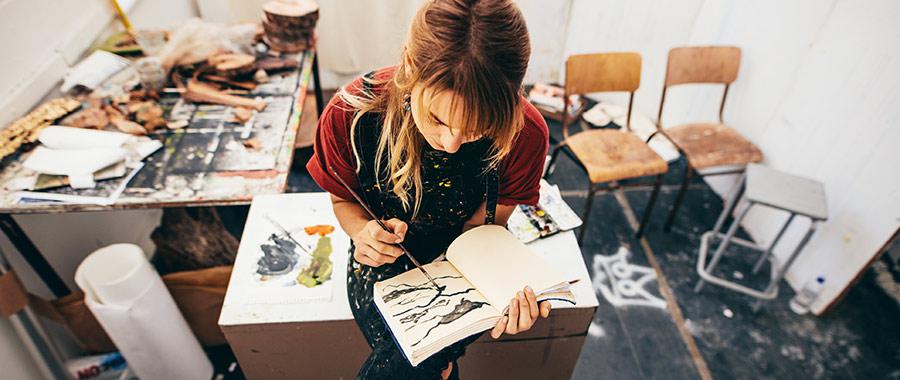Artistic inspiration is an enigmatic force, a phenomenon that has captivated the minds of philosophers, artists, and spiritual thinkers across cultures and epochs. Within the context of Bahá’í teachings, this inquiry delves into the intrinsic relationships between art, the human spirit, and divine influence. The question then arises: where does artistic inspiration truly originate? By exploring this multifaceted topic, we can uncover the profound implications of the Bahá’í perspective on creativity and its celestial connections.
Firstly, it is essential to understand art not merely as a product of human endeavor but as a vital expression of the human spirit. In the Bahá’í view, all humans possess the divine potential to create beauty and truth. This potential is not confined solely to the arts but permeates all facets of life. Therefore, artistic expression can be seen as a reflection of the divine attributes inherent within each individual. These attributes include creativity, imagination, love, and beauty, fostering a sense of interconnectedness among all beings.
Secondly, Bahá’í teachings emphasize that inspiration often manifests through the spirit of humanity. There exists a symbiotic relationship between the artist and the larger community; thus, personal experiences and collective narratives become woven into an artist’s work. Whether through literature, visual arts, or music, artists act as conduits for expressing universal truths that resonate with the human experience. This communal aspect of creativity serves to amplify the artist’s voice while simultaneously connecting to others who share similar sentiments, concerns, and aspirations.
Moreover, the quest for artistic inspiration is often accompanied by periods of struggle and introspection. Many artists encounter blocks or doubts that challenge their capacity to express their vision. In this context, Bahá’í teachings offer a perspective of resilience and perseverance. Embracing these challenges provides an opportunity for personal growth, as artists align themselves with their true purpose. It is during moments of adversity that deeper insights can be gleaned, allowing for artistic breakthroughs that enrich both the individual and the community.
The Bahá’í view posits that the search for inspiration is not merely an internal quest; it is intricately linked to the divine guidance that permeates the universe. The concept of “inspiration” itself can be understood as a spiritual phenomenon. When engaged in the creative process, an artist may experience sudden bursts of clarity or insight, often described as moments of divine illumination. These moments can inspire a sublime sense of purpose and drive, compelling the artist to share their vision with the world. In this light, inspiration is a partnership between the seeker and the divine, emphasizing the importance of attunement to higher realities.
Furthermore, the Bahá’í teachings advocate for the cultivation of virtues that nurture artistic inspiration. Qualities such as humility, patience, and discipline contribute to an artist’s ability to connect with divine guidance. By fostering these virtues, artists can transcend the limitations of ego, enabling them to channel a greater source of creativity. This selflessness not only enhances the quality of their work but also enriches the collective culture, contributing to the evolution of art as a transformative force.
In addition, the recognition of beauty as an essential component of artistic inspiration is paramount. According to Bahá’í thought, beauty serves as a reflection of the divine, acting as a bridge between the material and the spiritual realms. Artists who can perceive and convey beauty in their work elevate their creations, allowing viewers to transcend the mundane and engage with profound universal themes. In this realm, artistic inspiration becomes a spiritual pursuit—an exploration of the divine mysteries that govern existence.
Another significant aspect of where artistic inspiration comes from is the deliberate integration of diverse influences and traditions. The Bahá’í teachings encourage the examination and appreciation of myriad cultural expressions. An artist enriches their work by drawing upon various ideas, techniques, and aesthetics from around the world. This intercultural dialogue fosters innovation, expanding the horizons of understanding and unlocking novel narratives. Artistic inspiration flourishes in environments that celebrate diversity and open-mindedness, embodying the Bahá’í principle of unity in diversity.
As we reflect further on the nature of artistic inspiration, it becomes crucial to acknowledge the role of intention. In Bahá’í philosophy, the artist’s intention shapes not only the outcome of their work but also the impact it has on society. When an artist seeks to promote unity, healing, and transcendence, their creations resonate more profoundly with audiences. This intention, when rooted in a desire for the betterment of humanity, transcends mere self-expression and transforms into a vehicle for social change. The narrative becomes a collective one, emphasizing the shared human experience.
In conclusion, the exploration of where artistic inspiration emerges reveals a complex interplay of divine influence, personal struggle, communal narratives, and cultural exchange. The Bahá’í teachings illuminate this terrain, elucidating the intrinsic connection between creativity and spirituality. By fostering virtues, embracing beauty, and cultivating a spirit of unity, artists can uncover wellsprings of inspiration that transcend the individual self. Ultimately, artistic creation is not simply an act of personal fulfillment but a journey that enriches the collective experience and enriches humanity’s quest for truth and beauty.
